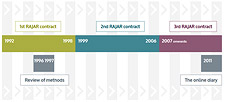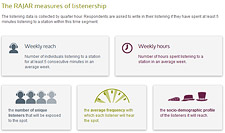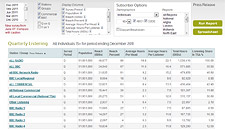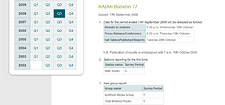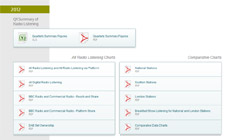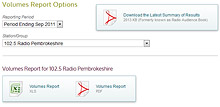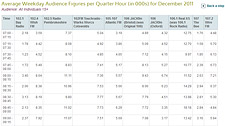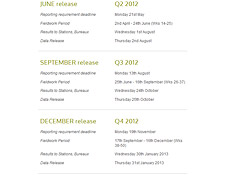Using the data
General Misuse and Misinterpretation
RAJAR is most concerned that there should be no misuse or misrepresentation of information and, if necessary, may restrict publication rights.
Misuse includes:
- the publication or other dissemination of results prior to the embargo date and time specified for the 'Quarterly Summary of Radio Listening'.
- the publication of data provided for internal use only - for example, monthly results, data for 'opt out' services or sub-area analyses.
Misrepresentation of the data may be seen to have occurred where:
- the universe, area or time period to which figures relate is not clear.
- the results are published based on inadequate sample sizes (as defined by RAJAR in the event of dispute).
- direct or implicit comparisons are drawn between basically dissimilar sets of data.
- a difference between two periods is interpreted as a real change in listening behaviour without checking for statistical significance.
In the case of doubt about the validity of an analysis or claim, consultation with RAJAR is strongly advised.
The RAJAR Board has indicated that it will take a strong view of the abuse of the publication rules, and any organisation misusing or misrepresenting the data can expect action to be taken against it.
RAJAR Publication Code
Publication includes - but is not limited to - press releases, press packs and briefings, promotional and marketing material, and sales presentations. Any use of RAJAR results outside the station or group is, therefore, defined as 'publication'.
The ad-hoc use of RAJAR data for planning systems is subject to special conventions, which are set out in section 7 of the Publication Code. Within this context, publication includes the use of RAJAR data in negotiations by any RAJAR subscriber.
Confidence Limits
The table on this page sets out the "confidence intervals" which can be given to percentages according to the size of sample used. The larger the sample, the narrower the band and the more the observed percentage is likely to lie close to the true population figure.
Example
For a sample size of 650, and an observed percentage at around 20%, the table shows that there are 95 chances in 100 of the true percentage lying between 15% and 25%; in other words, the sample percentage of 20% is estimated to be accurate to ± 5%.
Confidence intervals applicable to percentages at or near the following levels (95% confidence)
| Sample Size | Observed Percentage | |||||||
|---|---|---|---|---|---|---|---|---|
| 2% | 3% | 5% | 10% | 20% | 30% | 40% | 50% | |
| +/-% | +/-% | +/-% | +/-% | +/-% | +/-% | +/-% | +/-% | |
| 50 | 6 | 8 | 10 | 14 | 18 | 21 | 22 | 23 |
| 75 | 5 | 6 | 8 | 11 | 15 | 17 | 18 | 19 |
| 100 | 5 | 5 | 7 | 10 | 13 | 15 | 16 | 16 |
| 150 | 4 | 4 | 6 | 8 | 10 | 12 | 13 | 13 |
| 200 | 3 | 4 | 5 | 7 | 9 | 10 | 11 | 11 |
| 300 | 3 | 3 | 4 | 6 | 7 | 9 | 9 | 9 |
| 500 | 2 | 2 | 3 | 4 | 6 | 7 | 7 | 7 |
| 650 | 2 | 2 | 3 | 4 | 5 | 6 | 6 | 6 |
| 1000 | 1 | 2 | 2 | 3 | 4 | 5 | 5 | 5 |
| 1250 | 1 | 2 | 2 | 3 | 4 | 4 | 4 | 5 |
| 1500 | 1 | 1 | 2 | 2 | 3 | 4 | 4 | 4 |
| 2000 | 1 | 1 | 2 | 2 | 3 | 3 | 4 | 4 |
| 3000 | 1 | 1 | 1 | 2 | 2 | 3 | 3 | 3 |
| 4500 | 1 | 1 | 1 | 1 | 2 | 2 | 2 | 2 |
| 5000 | 1 | 1 | 1 | 1 | 2 | 2 | 2 | 2 |
Technical Note
The confidence intervals given in the table for a percentage p on a sample size n are given by

where 1.96 is the multiple of standard error required for 95% confidence, 1.64 the estimated design factor for the national adult sample of the RAJAR survey, and the latter part is the formula for a random sample standard error. It should be noted that the design factor may vary by service. The confidence intervals given in the table are thus indications only to their likely magnitude rather than accurate estimates for each individual case.


